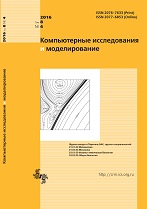|
MODELS IN PHYSICS AND TECHNOLOGY
On contact instabilities of viscoplastic fluids in three-dimensional setting
A. N. Doludenko
Joint Institute for High Temperatures of the Russian Academy of Sciences,
13 Izhorskaya st., Bd. 2, Moscow, 125412, Russia
Abstract:
The Richtmyer–Meshkov and the Rayleigh–Taylor instabilities of viscoplastic (or the Bingham) fluids are studied in the three-dimensional formulation of the problem. A numerical modeling of the intermixing of two fluids with different rheology, whose densities differ twice, as a result of instabilities development process has been carried out. The development of the Richtmyer–Meshkov and the Rayleigh–Taylor instabilities of the Bingham fluids is analyzed utilizing the MacCormack and the Volume of Fluid (VOF) methods to reconstruct the interface during the process. Both the results of numerical simulation of the named instabilities of the Bingham liquids and their comparison with theory and the results of the Newtonian fluid simulation are presented. Critical amplitude of the initial perturbation of the contact boundary velocity field at which the development of instabilities begins was estimated. This critical amplitude presents because of the yield stress exists in the Bingham fluids. Results of numerical calculations show that the yield stress of viscoplastic fluid sessentially affects the nature of the development of both Rayleigh–Taylor and Richtmyer–Meshkov instabilities. If the amplitude of the initial perturbation is less than the critical value, then the perturbation decays relatively quickly, and no instability develops. When the initial perturbation exceeds the critical amplitude, the nature of the instability development resembles that of the Newtonian fluid. In a case of the Richtmyer–Meshkov instability, the critical amplitudes of the initial perturbation of the contact boundary at different values of the yield stress are estimated. There is a distinction in behavior of the non-Newtonian fluid in a plane case: with the same value of the yield stress in three-dimensional geometry, the range of the amplitude values of the initial perturbation, when fluid starts to transit from rest to motion, is significantly narrower. In addition, it is shown that the critical amplitude of the initial perturbation of the contact boundary for the Rayleigh–Taylor instability is lower than for the Richtmyer–Meshkov instability. This is due to the action of gravity, which helps the instability to develop and counteracts the forces of viscous friction.
Keywords:
instability, Rayleigh–Taylor, Richtmyer–Meshkov, Newtonian fluid, Bingham fluid.
Received: 06.03.2018
Revised: 01.06.2018
Accepted: 06.06.2018
Citation:
A. N. Doludenko, “On contact instabilities of viscoplastic fluids in three-dimensional setting”, Computer Research and Modeling, 10:4 (2018), 431–444
Linking options:
https://www.mathnet.ru/eng/crm456 https://www.mathnet.ru/eng/crm/v10/i4/p431
|

| Statistics & downloads: |
| Abstract page: | 166 | | Full-text PDF : | 88 | | References: | 31 |
|




 Contact us:
Contact us: Terms of Use
Terms of Use
 Registration to the website
Registration to the website Logotypes
Logotypes








 Citation in format
Citation in format 